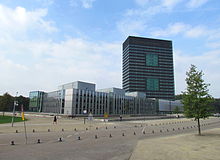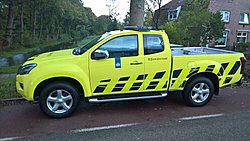
Thalys was a brand name used for high-speed train services between Paris Gare du Nord via Brussels-South to either Amsterdam Centraal or to German cities in the Rhein-Ruhr, including Aachen, Cologne, Düsseldorf, Duisburg, Essen and Dortmund.

The Zuid-Willemsvaart is a canal in the south of the Netherlands and the east of Belgium.

Amsterdam Zuid is a railway station situated in the borough of Amsterdam-Zuid in Amsterdam, Netherlands. For a number of years, it was named Amsterdam Zuid WTC, in reference to the neighbouring World Trade Center Amsterdam. During 2006, in conjunction with the rapid development of the area surrounding the station, the station was enlarged and the reference to the WTC was formally dropped from the name.

Rijksdienst voor het Cultureel Erfgoed often abbreviated as Cultureel Erfgoed, is a Dutch heritage organisation working for the protection and conservation of National Heritage Sites. It is located in Amersfoort, province of Utrecht.

The Veerse Meer is a lagoon in the southwest Netherlands in the province of Zeeland.

The Ministry of Transport, Public Works and Water Management was a Dutch ministry responsible for water management, public and private transport and infrastructure. It is now part of the Ministry of Infrastructure and Water Management.

The A28 motorway is a motorway in the Netherlands. It is approximately 188 kilometers in length.

Groningen railway station, locally called Hoofdstation, is the main railway station in Groningen in the Province of Groningen, Netherlands. It is located on the Harlingen–Nieuweschans railway between Zuidhorn and Groningen Europapark, on the Meppel–Groningen railway as terminus after Groningen Europapark, and on the Groningen–Delfzijl railway as terminus after Groningen Noord.
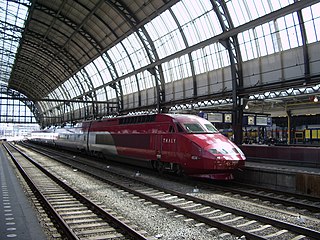
High-speed rail service in the Netherlands started on 13 December 2009 with the dedicated HSL-Zuid line that connects the Randstad via Brussels to the European high-speed rail network. In later years improved traditional rail sections were added to the high-speed network. Proposals for more dedicated high-speed lines were deemed too costly; plans for the HSL-Oost to Germany were mothballed and instead of the Zuiderzeelijn the less ambitious Hanzelijn was built to enable future high-speed service between the northern provinces and the Randstad.

Johannes Aleidis (Johan) Ringers was a Dutch hydraulic engineer and politician. He served as the director-general of Rijkswaterstaat and later as the director of Dutch East Indies Railways. During World War II, Ringers was appointed as the government commissioner for reconstruction, but was later interned by German forces.

The Voorne Canal is a former ship canal on Voorne-Putten in South Holland, the Netherlands. It was the first canal to connect Rotterdam to the sea. Construction of the canal started in 1826 and was completed in 1829. Until the completion of the Nieuwe Waterweg in 1872 it was the main connection from Rotterdam to the sea for ocean going ships.
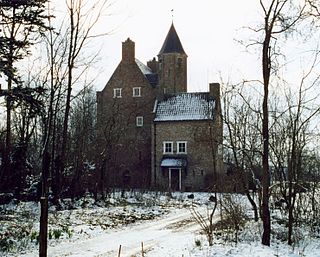
Sabbinge Castle is a small castle in Oud-Sabbinge, on the former island Wolphaartsdijk

The Wilhelmina Canal is a canal in North-Brabant, Netherlands. It connects Tilburg to the Meuse, and continues to the east to connect to the Zuid-Willemsvaart north of Helmond.

Wessem-Nederweert Canal is a canal connecting the Zuid-Willemsvaart at Nederweert to the Meuse near Wessem. Here it meets the wide Juliana Canal that connects to Maastricht.

Elizabeth Frederika van den Ban, known as Elze, was a Dutch urban planner and chief engineer of the Rijkswaterstaat at Zuiderzee Works where she introduced curvatures rather than straight lines into the urban planning process of polders and dikes. Van den Ban was the first woman from the Netherlands to graduate as a civil engineer in Delft, where she worked as a civil engineer.
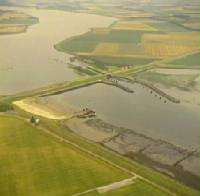
The Zandkreekdam is a compartmentalisation dam located approximately 3 kilometres north of the city of Goes in The Netherlands, which connects Zuid-Beveland with Noord-Beveland, and separates the Oosterschelde from the Veerse Meer.

Pieter Abraham van de Velde was a Dutch civil engineer and professor of road and hydraulic engineering. He contributed to several major water engineering projects in the Netherlands, notably the drainage of Walcheren at the end of the Second World War, dike restorations following the 1953 North Sea flood, and the Deltaplan.
Herman Arend Ferguson was a Dutch civil engineer and hydraulic engineer who contributed to water management in The Netherlands. He played a central role in the recovery efforts following the inundation of Walcheren in 1944, and the works to repair the significant damage caused by the North Sea flood of 1953. He held senior positions at Rijkswaterstaat, authored several key publications on hydraulic engineering, and was awarded the Order of the Netherlands Lion.

